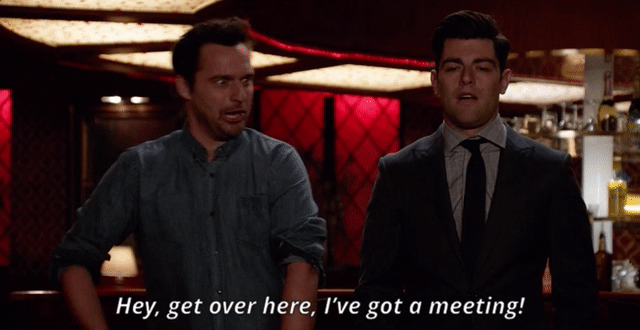We’ve all experienced the mind-numbing, pointless monotony of unproductive meetings that monopolize the day, strip us of joy, and destroy every bone in our once motivated and productive bodies.
(Or something like that.)
Point is, we all know meetings shouldn’t be that way, but yet round and round we go, right?
So, how do you stop meeting like this and transform your work meetings into the engines of action that you and your business deserve?
Here’s where to start!
1. Get to the source of the problem
Chances are, unproductive, ineffective meetings are systemic to the culture of your organization – even if your organization is teeny-tiny. Most companies hold too many meetings, it’s just a fact of life.
Change starts with the individual – which we’ll get to in a sec – but it doesn’t hurt to advocate for and adopt a company-wide meeting productivity policy.
Outline the do’s and don’ts of meetings. Post the policy for everyone (including the remote folks) to see. And most importantly, adjust your approach as you learn what works for your organization.
We know, we know. Changing the way an entire organization operates and thinks takes time. But when you jump right in and lead by example, you’ll be amazed at how contagious productive meetings are!
2. Remember, meetings aren’t a spectator sport
If you’re scheduling a meeting, figure out who absolutely NEEDS to attend. When in doubt, leave ‘em off.
Unless someone is getting on a spaceship without radio transmitters tomorrow, you can update them on applicable takeaways after the meeting.
After all, why should they sit through the entire meeting just in case?
If you value your coworkers, then you should also value their time.
Spectator meetings are a waste of time. Besides, smaller meetings are where it’s at. Nonverbal cues aren’t lost in the crowd. More people jump to and have time to contribute, and your discussions can be more focused.
(Tip: At MeetEdgar, we maintain an open-door approach to meetings. If somebody sees one they want to join, they’re more than welcome! The important thing is to give people the option.)
Of course, oversights happen, agendas shift, and folks that initially made sense to include may no longer be needed.
Which leads us to our next point!
3. Implement the tap-out rule
If you added Stan from accounting to a meeting, but discussions take a needed detour from the original agenda, set the precedent that it’s cool for Stan to dip on outta there if the conversation no longer applies to him or his area of expertise.
Also consider rotating meetings, where attendees leave and join during the stage that applies to them. If the group pivots to a new topic that is important but no longer applies to half the people, vocalize this shift and give people an out.
Streamline those who attend the meeting, so peeps can make time for more important priorities, like prepping for their next Facebook Live broadcast, getting that social media strategy in check, and finally trying that new taco truck around the corner (we hear their guac is to die for!).
4. Kill unproductive meetings by geting personal with the one-on-one
Sometimes the meetings that are literally as small as possible end up being the most productive – we’re talking about one-on-ones.
Keep one-on-ones collaborative, actionable, personal, and focused. Create a relaxed and comfortable environment for discussions. Consider mixing things up and chatting over coffee or relocating to a relaxing spot outside.
(Because honestly, a one-on-one meeting with your boss can be kind of a stressful situation under the wrong circumstances.)
Whether they’re routine or impromptu, make sure one-on-ones are mutually beneficial by spending as much time listening as you do talking!
5. Reset the baseline
Why is an hour the go-to for a meeting? Well, first of all, your Gmail or Outlook calendar defaults to one-hour blocks when you set up a new event.
Reset the norm by testing how short you can actively make a meeting. If your discussion only needs 10 minutes, great! Talking about something more complex? Make it longer!
Think back to high school science class. The contents of a meeting are like a gas – they’ll expand to fill up the size of whatever container you choose.
If you block off an hour on the calendar, a meeting that could have wrapped in 15 minutes will easily expand to fill that hour!
Keep your meetings focused efficient. They should facilitate momentum – don’t hold up progress waiting for a monthly check-in when a quick 10-minuter will do the trick!
In fact, always identify the most efficient way to reach your desired goals.
Before holding or attending a meeting, always ask yourself, “Is this meeting needed?”
Figure out the most productive and effective way to communicate or discuss the subject matter at hand. Is it email, phone, Slack, carrier pigeon, or a meeting?
If you question the reason you’re included on a meeting, don’t be afraid to speak up. (If you question the reason you’ve called a meeting, speak up to yourself!) If an email will do the trick, let people digest your info when it’s most convenient for them.
6. Set a meeting objective and a flexible agenda
Leave the surprises for your birthday (and that road trip to Mexico).
Make sure you outline meeting outcomes before sending someone the calendar invite.
That way, peeps have time to prepare, think through solutions, and be 100% ready to go when it’s time.
If you’re asking people to come prepared, don’t create a bunch of busy work. (We love a good PowerPoint presentation and all, but formalities aren’t always that necessary.)
State the purpose of your meeting, but also hash out a loose agenda.
If you pre prepare an agenda for a meeting, you’ll be able to stay on track with the matter in hand. Remember, it’s your job to keep the discussion on-topic, but leave room to shift gears based on priorities that surface during your meeting.
7. Remember the remote folks
If you have a remote team, rock the video meeting. Sometimes a quick phone call is in order, but for other cases, seeing your virtual team face-to-face goes a long way.
(Fun fact: we never do plain ol’ phone calls. We’re all about those futuristic video chats.)
Heck, throw on your favorite dress shirt and rock your underwear for all we care. The point is that face-to-face communication (even via video) promotes relationship building, positive energy, and productivity!
After all, how can you be productive if you can’t read the room?
Without video, you’ll never know if that silence is because everyone is nodding their heads in agreement, laughing on mute, or walking their dog.
(If you’re remote like us, find out what you need in your work-from-home survival kit.)
8. Ban phone faces
Studies show that a person attempting to multitask takes longer to accomplish a task and makes more mistakes.
(Which explains why we keep wandering into traffic when we’re focused on our morning bagel.)
Besides the benefits that come with giving your full attention to a conversation, it’s kind of rude not to – so if you’re holding an in-person meeting, encourage people to keep their distractions to a minimum.
Unless you’re using your computer to take notes or share information, close your laptop, stash your phone in your pants (or lederhosen, or whatever), and practice some good old fashioned active listening.
This is another reason that tap-out rule from earlier is so important – if you don’t need to be there, you’re better off leaving than sitting around bored and playing Angry Birds.
9. Fuel post-meeting momentum
A productive and lively meeting won’t always be cut and dry. Ideas will be challenged, scenarios discussed, and priorities evaluated.
Don’t assume everyone has the same takeaways as you. Save a few minutes at the conclusion of a meeting to recap the key outcomes and actionable next steps. Also, agree on an owner for each next step, so there’s no confusion.
Notice how we said agree on an owner? That means making it a conversation, so peeps can chime in about their workload and priorities that may not jive with project timelines.
While everyone should jot down their own takeaways, it’s also helpful for a designated person to summarize the outcomes and action items after the call wraps via Slack, email, Trello, white board, or cave painting.
A productive meeting has a way of motivating and energizing a team to efficiently and systematically work toward a common goal, so make sure everyone is on the same page!
When work gives you lemons, make lemon muffins
We’d be naïve to suggest that following these guidelines GUARANTEES that every meeting you hold or attend will be all sugar plum fairies and productivity.
We get it. Productivity – especially in a group situation – takes practice.
(And mindfulness, but we dedicated an entire post to that!)
It won’t happen overnight. You can’t hijack every single meeting, kick out the people that don’t need to be there, and force productivity.
You need to get to the source of the problem, advocate for a company-wide adjustment, and lead by example.
Even so, you can’t control every situation or meeting, and that means taking advantage of opportunities as they come.
If you focus on the opportunity and the positives, you’ll be shocked at what you gain.
Your turn! What’s YOUR approach to meetings?
How do you or your company make meetings more productive? Are internal meetings a must have?
Any do’s and don’ts to share?
Anything we missed (or you don’t agree with)?
Strut your stuff in the comments below!








1 Comment
Lead by example. I think this is indeed the best way to make things change.